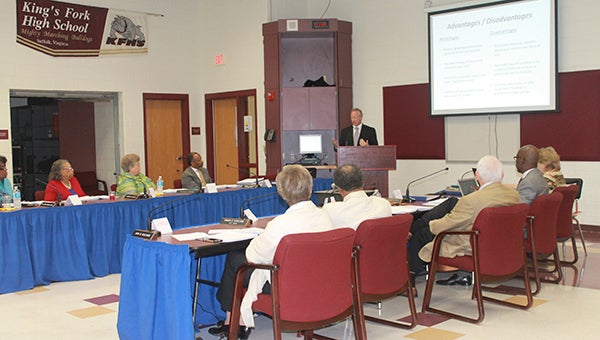Board supports energy
Published 10:22 pm Friday, August 21, 2015

Director of Facilities and Planning Terry Napier speaks to the School Board during its Thursday retreat about the energy conservation project. From left are Dr. Judith Brooks-Buck, Lorraine B. Skeeter, Phyllis C. Byrum, School Board Attorney Wendell M. Walker, Linda W. Bouchard, Vice Chair Enoch C. Copeland, Chairman Michael J. Debranski, Superintendent Deran R. Whitney, and Clerk Cynthia Chavis.
By Alyssa Esposito
Staff Writer
In an effort to leave a smaller carbon footprint and save money, Suffolk Public Schools is considering replacing school equipment to conserve energy.
“They’ve already voted on the fact that they want to move forward with the actual preliminary assessment. And the next step would be the detailed proposal,” Superintendent Deran Whitney said Thursday during the School Board’s annual retreat.
The board previously voted on May 14 to move forward with the project, but it received additional information on the process Thursday. Energy performance contracting has been a topic of conversation in the city and school system since it was proposed in the City School Advisory Committee on Collaborative Fiscal Concerns.
Director of Facilities and Planning Terry Napier told the School Board the project would cost no money up front.
The first step in the process is a free assessment that would come up with a rough estimate of the amount of energy and money currently being used and the amount that could be saved after installing new equipment.
Napier said the debt used to pay for the new equipment would be paid back over time from the money saved through energy reduction. But some members of the board wondered what would happen if the energy and money savings don’t turn out to be as significant as expected.
Napier assured them however, that the energy company creates a contract with the client in which they put themselves on the line for the money if there are miscalculations in the expected amount of savings.
Napier discussed advantages and disadvantages to the project. While it could offer the chance to save a lot of money — not just in terms of energy bills, but also in terms of maintenance — there could be restrictions put on the school as to how their energy is used. Stipulations such as turning lights off at a certain time could be put into the contract and must be fulfilled. If not, the company would not be held liable for paying back the loan.
The fact that schools use lights during the school day and occasionally in the evenings for events was another topic discussed by the board. Napier said the restrictions would be ones that are attainable based on the current use of energy in the school.
Following the preliminary assessment, if the board decides to move forward, a detailed proposal would take place, followed by signing a contract and the installation of the equipment.
The savings will not actually be going towards the school division for a number of years. If the division saves what it is projected to save, the money will go straight to the lender until the debt has been paid off. While quite a bit of money could be saved in the long run, the savings will not be usable by the division until the loan has been paid back.






